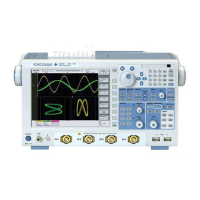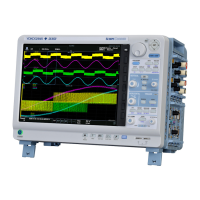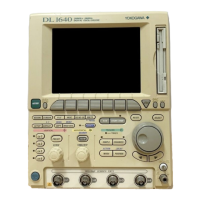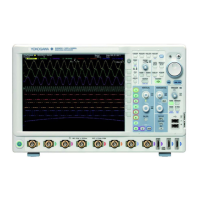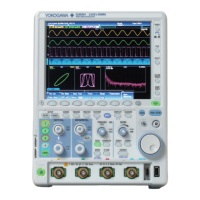4.4 Data
<Voltage>, <Time>, <Frequency>, and <Current>
<Voltage>, <Time>, <Frequency>, and <Current>
indicate decimal values that have physical significance.
<Multiplier> or <Unit> can be attached to the <NRf>
form that was described earlier. It is expressed in one
of the following forms.
Form Example
<NRf><Multiplier><Unit>
5MV
<NRf><Unit>
5E-3V
<NRf><Multiplier>
5M
<NRf>
5E-3
<Multiplier>
<Multipliers> which can be used are indicated
below.
Symbol Word Multiplier
EX Exa 10
18
PE Peta 10
15
T Tera 10
12
G Giga 10
9
MA Mega 10
6
K Kilo 10
3
M Milli 10
–3
U Micro 10
–6
N Nano 10
–9
P Pico 10
–12
F Femto 10
–15
A Ato 10
–18
<Unit>
<Units> that can be used are indicated below.
Symbol Word Meaning
V Volt Voltage
S Second Time
HZ Hertz Frequency
MHZ Megahertz Frequency
A Ampere Current
• <Multiplier> and <Unit> are not case sensitive.
• “U” is used to indicate micro “
µ
”.
• “MA” is used for Mega to distinguish it from Milli.
The only exception is Megahertz which is expressed
a
s “MHZ.” Therefore, the “M (Milli)” multiplier cannot
be used for frequencies.
•
If both <Multiplier> and <Unit> are omitted, the
default unit is used.
• Response messages are always expressed in the
<NR3> form. Response messages are returned
using the default unit without the <Multiplier> or
<Unit>.
Data
A data section comes after the header. A space must be
included between the header and the data. The data
contains conditions and values. Data is classified as below.
Data Meaning
<Decimal> A value expressed as a decimal number
(Example: Probe attenuation of CH1
-> CHANnel1:PROBe 100
)
<Voltage><Time>
A physical value
<Frequency> (Example: Time axis range
<Current>
-> TIMebase:TDIV 1US
)
<Register>
Register value expressed as binary
, octal,
decimal or hexadecimal.
(Example: Extended event register value
-> STATUS:EESE #HFE
)
<Character Data> Predefined character string (mnemonic).
Can be selected from { }.
(Example: Select the input coupling of CH1
-> CHANnel1:COUPling
{AC|DC|DC50|GND}
)
<Boolean> Indicates ON and OFF
. Set using ON,
OFF or a value
(Example: Turn ON the CH1 display
-> CHANnel1:DISPlay ON
)
<String data> An arbitrary character string
(Example: Comment to a screen data output
-> MATH1:UNIT:USERdefine "VOLT"
)
<Filename> Indicates a file name.
(Example: Save file name
-> FILE:SAVE:WAVeform:NAME "CASE1"
)
<Block data> Arbitrary 8-bit data
(
Example: Response to acquired waveform data
-> #800000010ABCDEFGHIJ
)
<Decimal>
<Decimal> indicates a value expressed as a decimal
number, as shown in the table below. Decimal values
are given in the NR form as specified in the ANSI
X3.42-1975.
Symbol Meaning Example
<NR1> Integer
125-1 +1000
<NR2> Fixed-point number
125.0 -.90 +001.
<NR3> Floating-point number
125.0E+0 -9E-1 +.1E4
<NRf> Any of the forms <NR1> to <NR3> is allowed.
• The instrument can receive decimal values that are
sent from the controller in any of the forms, <NR1>
to <NR3>. This is represented by <NRf>.
•
For response messages that the instrument returns
to the controller
, the form (<NR1> to <NR3> to be
used) is determined by the query. The same form is
used regardless of the size of the value.
•
For the <NR3> format, the “+” sign after the “E” can
b
e omitted. However, the “-” sign cannot be omitted.
• If a value outside the setting range is entered, the
value is normalized so that it is just inside the range.
• If a value has more significant digits than the
available resolution, the value is rounded.
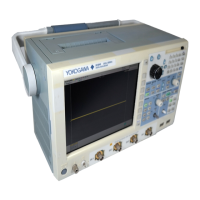
